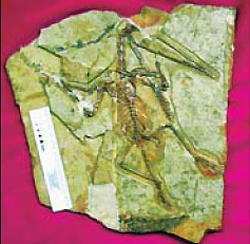| Fossil mom helps shed light on ancient life | ||||
The fossil of a female pterosaur known as Mrs T. [Provided to China Daily] She was gliding over a lake on her way to a patch of soft soil where she wanted to lay her egg when a sudden gust of suffocating toxic volcanic gas hit her, breaking her wing and plunging her into the water more than 160 million years ago. Mud on the lake bottom quickly buried the flying reptile`s body and, over time, it turned to rock. Now, researchers are celebrating the fact that the fossilized remains of the pterosaur they nicknamed Mrs T and her un-laid egg are shedding new light on ancient mysteries. They say the discovery of the fossil, which was unearthed in 2009 in Northeast China`s Liaoning province, has helped solve mysteries surrounding the creatures - including how to tell the difference between males and females. "The discovery of Mrs T has thoroughly resolved that longstanding question," said Lu Junchang, who led a team of paleontologists from China and Britain that worked on the find. Lu, who is also a researcher with the Beijing-based Institute of Geology, Chinese Academy of Geological Sciences, made the announcement on Friday at the same time as an article on the breakthrough appeared in Science magazine. The research team reported that the reptile, specified as a Darwinopterus, a mid-Jurassic pterosaur, was a sexually mature female and a rare example among fossilized pterosaurs because it was found along with an egg. Lu and his team said Mrs T and several other examples demonstrated that male pterosaurs had a relatively small pelvis and a large bone crest on top of the head, while females had a larger pelvis and no crest. Paleontologists had long wondered whether the crest belonged to males or females and whether its primary purpose was for fighting or attracting a mate. The egg found beside the hip of Mrs T measured about 3 centimeters in length and was thought to match the size of her body, added Lu. The wings of the pterosaur spanned more than 70 cm. Lu said it was clear that Mrs T was female and that the egg was her egg and not one snatched from another nest for food because the reptile would not have been strong enough to have carried such a large egg because her legs were too thin. The team reported that the shell of the egg was like parchment, a characteristic shared by all existing reptiles, including crocodiles and lizards. The fossil is now in the possession of the Zhejiang Museum of Natural History in Hangzhou, capital of East China`s Zhejiang province. |
||||
| Date:2011-1-24 10:07:41 | ||||
|
|
|
|
|
